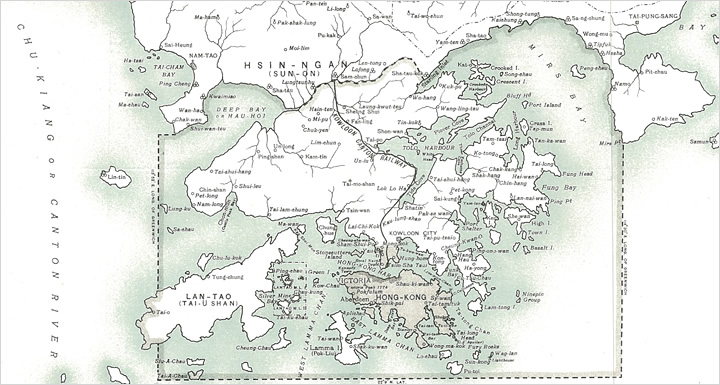
Christianity in China
Christianity has been in China for a very long time, but it has had difficulty growing roots. East Syrian missionaries from the Church of the East, the so-called Nestorians, went to China in the seventh century and then again in the thirteenth century (when the Franciscans also came) but the churches they established all but disappeared. Beginning in the late sixteenth century, Matteo Ricci and other Jesuits were successful in engaging in a dialogue with Chinese culture, but their efforts were cut short when Pope Clement XI condemned the Chinese Rites in 1715. Robert Morrison's arrival in Macau in 1807 represented the start of the Protestant mission in China. From then until at least the middle of the twentieth century, the development of Chinese Christianity was facilitated by the forces of colonialism and imperialism. The Church developed slowly, but until very recently it was seen as a "foreign" or even "colonial" church. It is important to recall the early Chinese Christian tradition, and the development of Christianity alongside colonialism, because they have both shaped the history of the Hong Kong Sheng Kung Hui.1
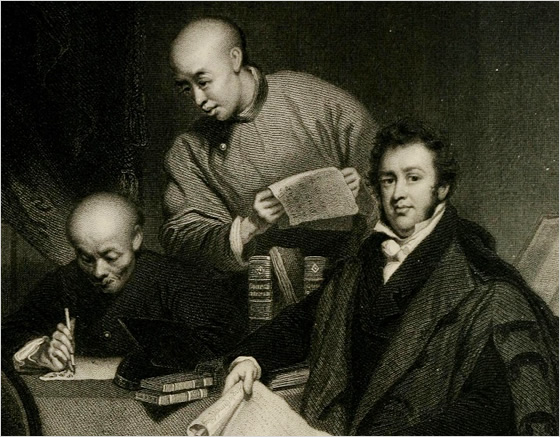
Dr. Robert Morrison, the first lay Protestant missionary in China, was also the first to translate and publish the Bible in Chinese |
Literal meaning of “Sheng Kung Hui”
Sheng Kung Hui(聖公會)literally means "Holy Catholic Church" in Chinese. It is a term created in the mid-nineteenth century and became the accepted name for the Church that British Anglican and American Episcopalian missionaries (later joined by the Canadians) were trying to establish in China. The same Chinese characters(聖公會)are used in the names of the Anglican Church of Korea, the Nippon Sei Ko Kai in Japan and other Chinese Anglican and Episcopal churches.
Today, the Hong Kong Sheng Kung Hui (HKSKH) is a province within the Anglican Communion, a Church in accordance with accepted traditions and usages of that communion, locally adapted, within the One Holy, Catholic and Apostolic Church. Ours is a Church "beyond colonial Anglicanism," and the HKSKH is very much more than an historical accident or a decadent legacy of Anglo-Saxon imperialism.2 We share a special history with other Chinese Anglican and Episcopal churches, in Asia and in the Chinese diaspora.
Early Anglican Missionaries in China and Hong Kong
The first Anglicans in China were chaplains employed by the East India Company, who arrived in Macau just a few years after Morrison. The Anglican Church in Hong Kong began with the appointment of Reverend Vincent Stanton as Colonial Chaplain in 1843. Hong Kong had been established as a British colony the previous year, and by the time Stanton arrived, there were already plans to erect a church. Stanton had been in China a few years earlier, but had then returned to England. There he began raising funds for what would become St. John's Cathedral (founded in 1849) and St. Paul's College (established 1851), one of the oldest secondary school in the territory.
In 1849, the Diocese of Victoria was created by Royal Letters Patent, and The Rt Reverend George Smith was appointed the first Diocesan Bishop. He too had been in China earlier, to investigate mission prospects for the Church Missionary Society (CMS). Over the next century, CMS sent more English missionaries to Hong Kong than any other area. Bishop Smith had a strong commitment in developing the Chinese Church, and spent much of his time on visitations in his diocese that included all of China and Japan. He ordained Lo Sam-yuen, the first Chinese deacon in Hong Kong, and began to build up the church in those parts of China under his jurisdiction.
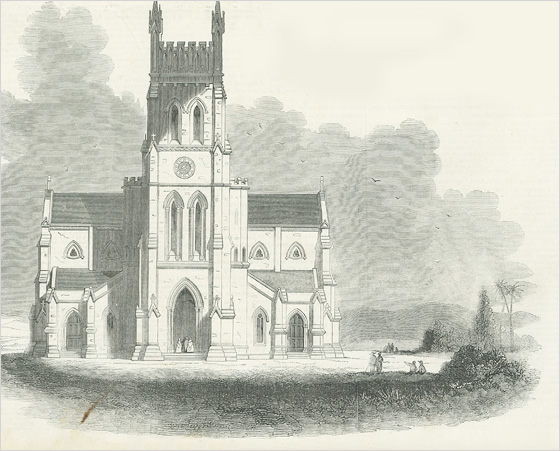
1847 Lithograph of St. John's Cathedral from the Pictorial Times, London |
Bishop Smith (1849-1864) and his successor Bishop Charles Richard Alford (1867-1872) had authority over what was the largest diocese there has ever been in the Anglican Communion. It included all of China, as well as Japan. Bishop Alford resigned his See when Victoria was split to form another new diocese of North China, for he saw it as a lessening of his authority. In 1883, Japan became a separate province-in-formation. In 1906, Fukien became a new diocese, and it was always the area with the largest concentration of Anglicans in China. In 1909, Kwangsi-Hunan became a separate diocese, and in 1947 the Yunkwei Diocese was created. These new dioceses indicated that the Church was growing, albeit slowly. In Hong Kong, society was rapidly changing as well, due to the building up of an infrastructure that encouraged trade, migration and investment.
Anglicans played an important role in establishing a mission to seafarers, in Hong Kong and other cities on the China coast. Although the Church was initially under the Colonial Office, St. John's Cathedral and the Diocese of Victoria, were, in effect, "disestablished and dis-endowed" by government decree in 1892. Henceforth, the Church would increasingly develop its own means of support, although education and social service work would continue to receive government funding and patronage.
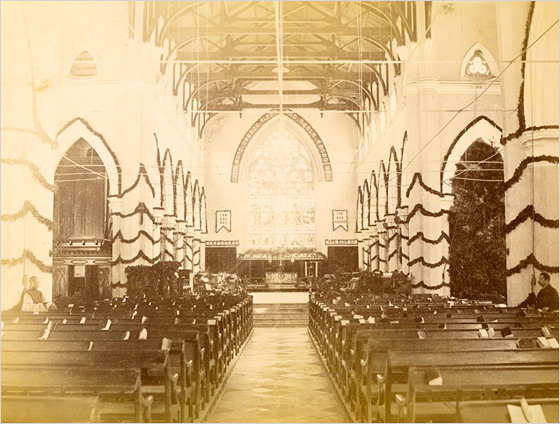
Interior of St. John's Cathedral, Christmas, circa 1895 |
CMS missionaries established primary and secondary schools in Hong Kong throughout the 19th and 20th centuries. Chinese Christians also played an important role in the education, and they pioneered in social welfare for the poor, including schools for the disadvantaged, almshouses for the elderly and free medical clinics. Both missionaries and Chinese Christians addressed key social issues such as opium use and the improvement of the status of women. A commitment to education and social welfare has always been an important feature of the mission of the Church in Hong Kong right up to the present.
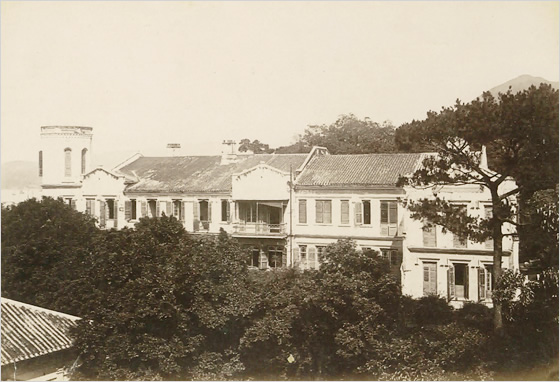
St. Paul's College (Bishop's House), 1897 |
Establishment of Chung Hua Sheng Kung Hui (CHSKH)
Due to the ecclesial tensions in China between the British, American and (later) Canadian missionaries up through the early twentieth century, the Bishops and clergy of the Sheng Kung Hui met in 1897, 1899, 1903 and 1909 to work for unity. These discussions led to the establishment of the Chung Hua Sheng Kung Hui ("The Holy Catholic Church of China") in 1912. This was the first major Christian Church in China. It was recognized as an independent province at the Seventh Lambeth Conference in 1930, by which time Chinese bishops, priests and laity were increasingly providing the ideas, leadership and direction for the Sheng Kung Hui.
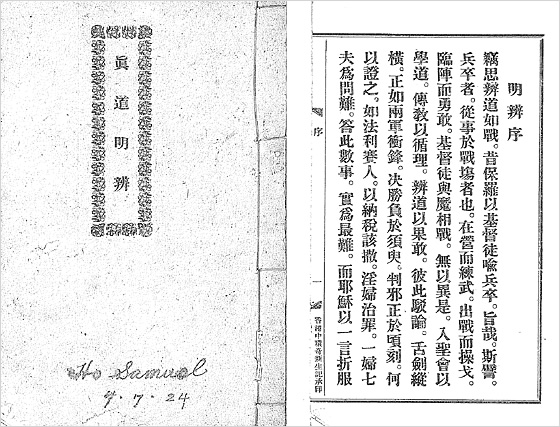
A Clear Defense of the True Way, 1915 by Kwong Yat-Shau (1840-1921) |
The (Chinese) Diocese of South China held its first Synod in 1913, and it also overlapped with the (English) Diocese of Victoria, which confined to the colony of Hong Kong. These overlapping dioceses, and the inevitable tensions between the English and the Chinese, created a certain confusion. In the Diocese of Victoria, the early bishops were appointed by the Colonial Office. They were also CMS men. Bishop Burdon (1874-1897) was a committed missionary as well as a sinologist who translated early versions of the New Testament and the Common Prayer Book. Some British residents in the colony complained that he never gave sufficient attention to them! Bishop Hoare (1898-1906), who had extensive experience with CMS in Ningpo, was the first Hong Kong bishop appointed by the Archbishop of Canterbury, not the Colonial Office. Bishops Lander (1906-1920) and Duppuy (1920-1932), who built up diocesan infrastructure and relations with the CHSKH, were appointed by Canterbury, as was Bishop R. O. Hall (1932-1966), but for the first time, his appointment was confirmed by the House of Bishops of the CHSKH.
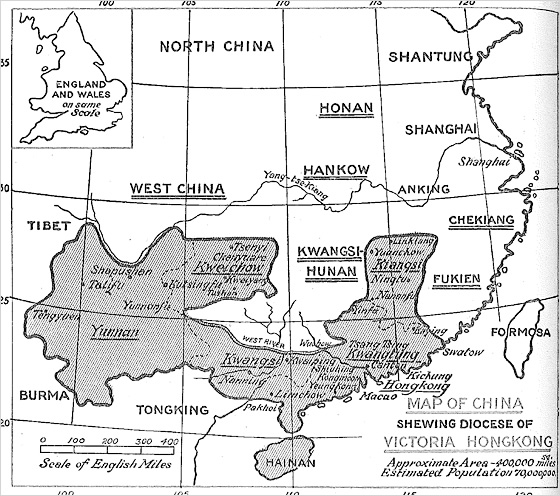
Map of the (Chinese) Diocese of South China in 1924 |
Development of Chinese Churches
The bishops and CMS missionaries supported the idea of the Church in Hong Kong becoming more Chinese, but the major work toward that end had to be done by Chinese Christians themselves. St. Stephen’s Church, the first Chinese Anglican Church in Hong Kong, was founded in 1865. It became the mother church of all the other Chinese churches started in the nineteenth century. Reverend Kwong Yat-Shau, was the first Chinese priest in charge of St. Stephens, and he also started Holy Trinity Church in Kowloon. Reverend Mok Shau Tsang worked under Kwong for a time, but he later returned to Canton, where he was appointed Assistant Bishop in 1934, and did much to build up the Sheng Kung Hui in parts of the diocese north of Hong Kong. Reverend Lee Kau Yan was a priest in the same tradition, combining work for church and society in a career spanning forty-five years. These three are examples of the strong Chinese clergy tradition that was emerging in Hong Kong. For all Chinese priests, before and since, contextualization by whatever name was a crucial issue for the Church.
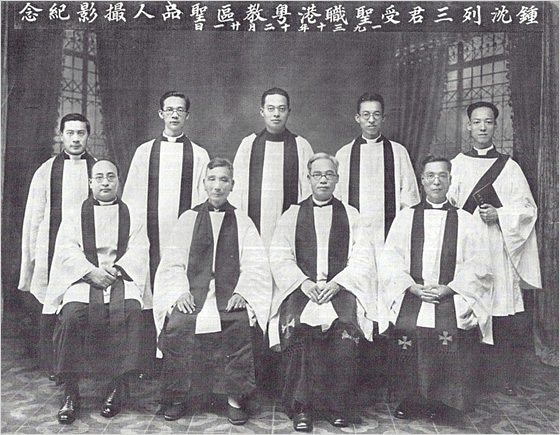
Group photo of the clergy of the Kong Yuet Diocese taken on 21st December, 1930
Back row from left: Lee Ying Pui (李應標), Chung Yan Lap (鍾仁立), Moyung Yin (慕容賢), Shen Han-hsin (沈漢生), Lit Po Wu (列蒲祜)
Front row from left: Tso Sze Fong (曹思晃), Mok Shau Tsang (莫壽增), Lee Kau Yan (李求恩), Tsang Kei Ngok (曾紀岳) |
|
Bishop R. O. Hall stands out as one of the great Anglican bishops of the last century. His background was the Student Christian Movement, not the CMS. Influenced by the theology of F. D. Maurice, an ecumenical spirit, and friendship with Chinese Christians, Hall's bishopric embraced the church and the world. He was immersed in Chinese culture and social issues. He began a program for non-stipendiary clergy in the late 1930s. During the Second World War, he stood with his church in Kunming, and raised support for relief efforts. In his ordination of Florence Li Tim-oi to the priesthood in 1944, Hall was far ahead of his time. Bishop Hall brought together the church, social welfare and education for the reconstruction of Hong Kong after the end of the war, and for the next two decades, he helped shape a new vision for the church and social renewal, as he kept up a busy schedule of presiding, preaching, speaking and theological writing.
|
|
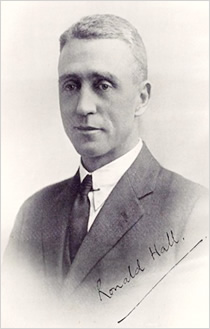
Bishop R. O. Hall |
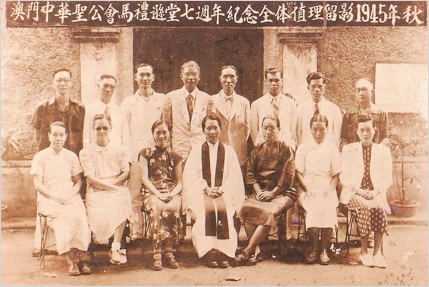
Florence Li Tim-oi, seated in the centre front, was in charge of the Morrison Chapel in Macau during World War II (autumn,1945) |
Post-war Years
In 1951, the Standing Committee of the CHSKH, acting on behalf of the Synod, petitioned the House of Bishops to create a new "Diocese of Hong Kong and Macau" to become a detached diocese, faithful in its order and worship to the Canons and Constitutions of the CHSKH. What had once been perhaps the largest diocese in the world, was now the smallest, in the territories of Hong Kong and Macau on the edge of a New China.
In the 1950s, refugees from the mainland poured into Hong Kong, and the church responded with new programs of outreach, education and mission. The Diocese of Hong Kong and Macau promoted ecumenical co-operation, and also started new schools, welfare settlements and parishes. There was little contact with the church in China during this time, although in 1956 Bishop Hall became the only Hong Kong church leader to visit the mainland in the 1950s. Later that same year, the tenth and last General Synod of the CHSKH was held in Shanghai, the year that was also the centennial of the Diocese of Victoria.3
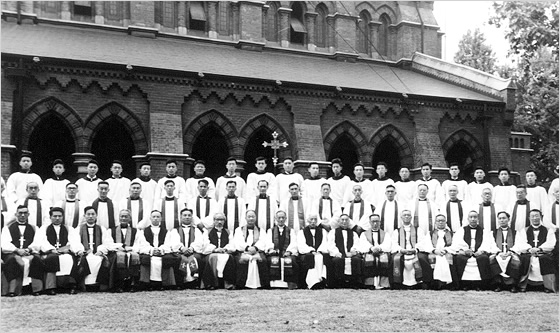
The last meeting of the CHSKH House of Bishops, Shanghai, 1956 |
The Diocese of Hong Kong and Macau
Bishop Gilbert Baker, who had worked many years in China, became the first elected bishop of the Diocese of Hong Kong and Macau in 1966, and the last Englishman to hold that office. He continued in the tradition of linking the church to education and social welfare, at a time when "Hong Kongers" were emerging with their own identity.4 Hong Kong is remembered for ordaining Florence Li Tim-oi as the first Anglican woman priest, but Bishop Baker ordained the second, third and fourth women to the Anglican priesthood as well, and all of them were "officially" approved in the Anglican Communion.5 The church has in this way pioneered in the ministry of Anglican women.
In 1981, Kwong Kong-kit Peter was elected the first Chinese bishop of Hong Kong and Macau. He guided the church with a steady hand and a clear vision over the next twenty-six years. Bishop Kwong was practice-oriented, good at bringing people together for mission. He reorganized church policies, structures and finances. He also helped build relationships with the Chinese government, thus ensuring a smooth transition for church and society over 1997. During the time of "reform and openness" in China. Bishop Kwong worked closely with the Chinese Christian Three-Self Patriotic Movement Committee (TSPM) and the newly established China Christian Council (CCC), structural expressions of the re-merging church on the mainland. The "post-denominational" CCC was in some sense a replacement of the CHSKH, and other Chinese denominations on the mainland.
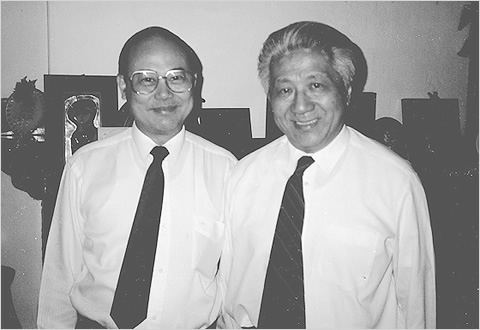
Bishop Peter Kong-kit Kwong (left) with Bishop Ting Kuang-hsun (right), former Anglican Bishop in mainland China and now Chairperson emeritus of the Three-Self Patriotic Movement (TSPM) and President emeritus of the China Christian Council |
Establishment of the Province
The major achievement of Bishop Peter Kwong's bishopric was the creation of the Province of Hong Kong Sheng Kung Hui. Early on, Bishop Kwong saw that a detached diocese, operating not under the constitution and canons of any province, was an anomaly. Although Hong Kong was part of the Council of The Churches of East Asia, together with other dioceses in the region, the Anglicans in Hong Kong needed a more formal institutional grounding. As Hong Kong was no longer under British administration, it could not become an extra-territorial diocese of Canterbury. And so, on 25 October, 1998, after seven years of planning, the Hong Kong Sheng Kung Hui was born. Bishop Kwong was elected the first Archbishop and Primate, working together with Bishop Soo Yee-po Thomas in the Diocese of Western Kowloon and Bishop Tsui Tsan-sang Louis in the Diocese of Eastern Kowloon to build up the Church.
Archbishop Peter Kwong retired in 2007. Bishop Paul Kwong of the Diocese of Hong Kong Island was then elected by the Electoral College to be the second Archbishop and Primate of the Province. Bishop Soo and Bishop Tsui subsequently retired in 2012 and 2014 respectively. Andrew Chan was elected as the second Diocesan Bishop of Western Kowloon. Timothy Kwok was elected as the second Diocesan Bishop of Eastern Kowloon.
As a province, initiatives have been taken in equipping the laity for mission, education, theological training, and in social welfare. Significant growth was achieved over the last decades. The HKSKH would continue to actively involve in the worldwide Anglican Communion, and with the Church on the mainland and in other parts of Asia.
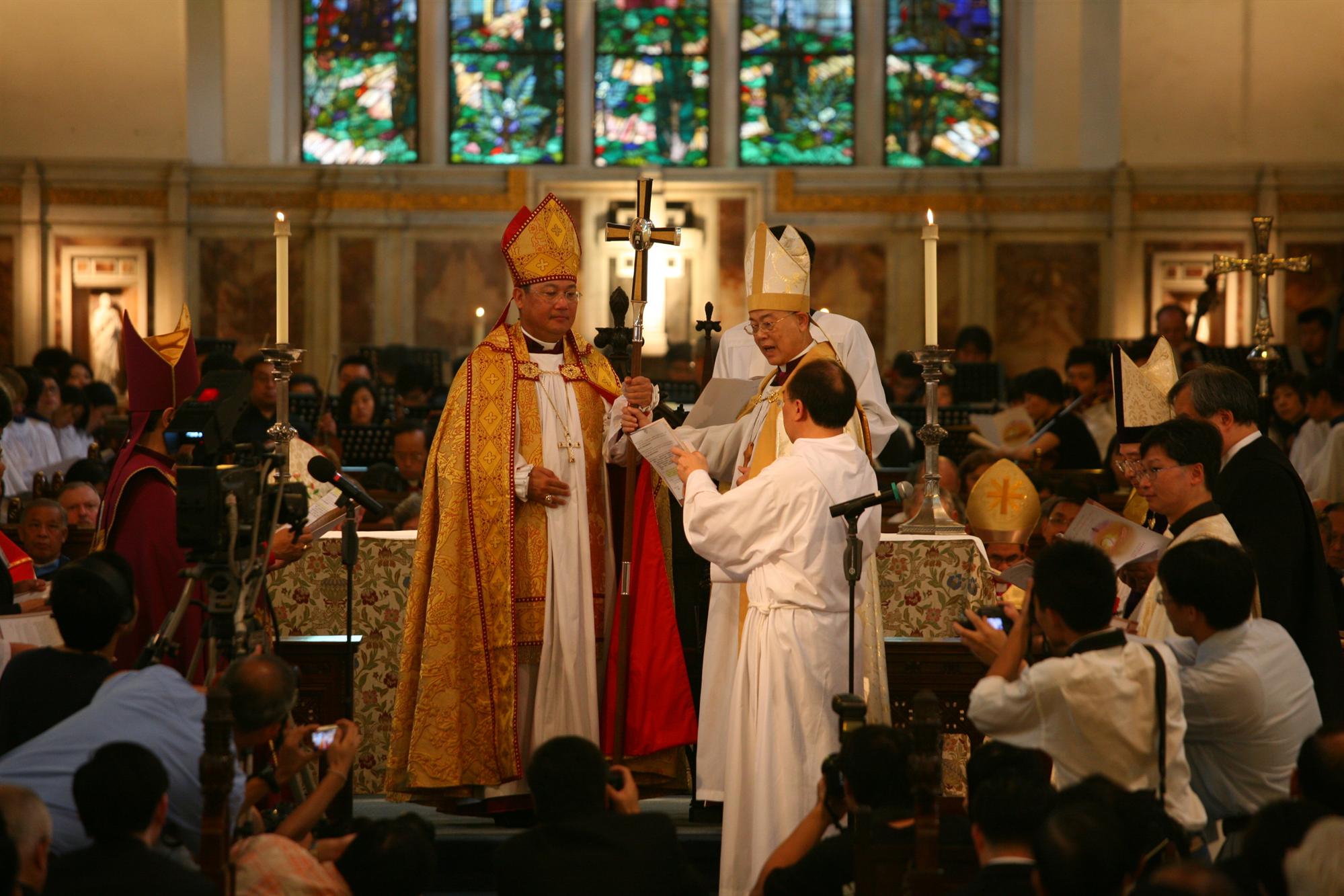
Istallation of Archbishop Paul Kwong on 26th September, 2007 |
We thank God for all that has been achieved, but we are keenly aware of the serious challenges that lie ahead.
A Brief Timeline of the Hong Kong Sheng Kung Hui
|
635 c.e.
|
The Church of the East brought Christianity to China |
|
|
1807
|
Arrival of Robert Morrison in Macau and the beginning of Protestant Christianity in China |
|
|
1835
|
American Episcopal Church sent two missionaries to China |
|
|
1842
|
Hong Kong became a crown colony of the United Kingdom |
|
|
1843
|
Vincent Stanton appointed as the first Colonial Chaplain in Hong Kong |
|
|
1849
|
Diocese of Victoria was established by Royal Letters Patent. George Smith was consecrated at Canterbury Cathedral as Bishop of Victoria (1849-1864), which included all of China and Japan |
|
|
1863
|
Lo Sam-yuen was ordained as the first Chinese deacon |
|
|
1865
|
St. Stephen's Church, the first Chinese Anglican Church in Hong Kong was founded |
|
|
1867
|
Charles R. Alford appointed the second Bishop of Victoria (1867-1872) |
|
|
1874
|
John Shaw Burdon consecrated the third Bishop of Victoria in Hong Kong (1874-1897) |
|
|
1884
|
Matthew Fong (Kwong) Yat-shau was ordained as the first Chinese Anglican priest in Hong Kong |
|
|
1884
|
The Anglican Mission to Seamen began in Hong Kong |
|
|
1897
|
First meeting of the British and American Anglican Bishops in China and Korea was held in Shanghai; subsequent meetings were held in 1899, 1903, 1907 and 1909 |
|
|
1898
|
Joseph Charles Hoare appointed the fourth Bishop of Victoria in Hong Kong (1898-1906) |
|
|
1902
|
The Church Body of the Chinese Anglican Church in Hong Kong was established |
|
|
1907
|
Gerard Heath Lander appointed the fifth Bishop of Victoria in Hong Kong (1907-1920) |
|
|
1912
|
Chung Hua Sheng Kung Hui (The Holy Catholic Church of China) was established in Shanghai |
|
|
1913
|
First Synod of the Diocese of South China (together with Diocese of Victoria) was held |
|
|
1920
|
Charles Ridley Duppuy appointed the sixth Bishop of Victoria in Hong Kong & the Diocese of South China (1920-1932) |
|
|
1930
|
Lambeth Conference formally recognized the Chung Hua Sheng Kung Hui as part of the Anglican Communion |
|
|
1932
|
Ronald Owen Hall appointed the seventh Bishop of Victoria in Hong Kong & the Diocese of South China (1932-1966) |
|
|
1934
|
Mok Shau Tsang appointed Assistant Bishop of the diocese |
|
|
1941-1945
|
Hong Kong under Japanese occupation during World War II |
|
|
1944
|
Ordination of Florence Li Tim-oi to priesthood by Bishop R. O. Hall. She was the first woman priest in the Anglican Communion |
|
|
1949
|
The People's Republic of China was established |
|
|
1951
|
The Diocese of Hong Kong and Macau established and detached from the Holy Catholic Church of China |
|
|
1956
|
Last general synod of the Chung Hua Sheng Kung Hui was held in Shanghai |
|
|
1966
|
John Gilbert Baker elected the eighth Bishop of Hong Kong (1966-1981) by the Diocesan Synod |
|
|
1973
|
HKSKH Social Welfare Council was established |
|
|
1981
|
Kwong Kong Kit Peter consecrated as the ninth Bishop of Hong Kong (1981-2006) |
|
|
1997
|
The return of Hong Kong to Chinese sovereignty |
|
|
1998
|
Inauguration of the Province of the Hong Kong Sheng Kung Hui, 38th Province in the Anglican Communion. Kwong Kong Kit Peter was installed to be the first Archbishop and Primate |
|
|
2007
|
Paul Kwong elected the second HKSKH Archbishop and Primate |
|
|
Note: This brief overview of the history of the Hong Kong Sheng Kung Hui is adapted from Archbishop Paul Kong and the Revd Philip L. Wickeri, "Sheng Kung Hui: The Contextualization of Anglicanism in Hong Kong," a chapter in the forthcoming Oxford Handbook of Anglican Studies (2011).
1 The importance of the Chinese Christian tradition for the Sheng Kung Hui was summarized by HKSKH priest Shiu Keung Lee in The Cross and the Lotus (Hong Kong: The Christian Study Centre on Chinese Religion and Culture, 1971). For the legacy and the continuing influence of imperialism on the mission of the Church in former British colonies see Norman Etherington, ed., Missions and Empire (New York: Oxford University Press, 2008).
2 See Ian T. Douglas and Kwok Pui-lan, eds., Beyond Colonial Anglicanism: The Anglican Communion in the Twenty-First Century (New York: Church Publishing, 2001). This volume has its origins in a conversation between Profs. Douglas and Kwok (who is from Hong Kong) on the return of Hong Kong to China in 1997. The characterization in the last part of this sentence is adapted from Paul Avis, "What is 'Anglicanism'?" in Stephen Sykes and John Booty, eds. The Study of Anglicanism (London and Philadelphia: SPCK and Fortress Press, 1988), p. 405.
3 Two histories were prepared for the centennial, both written at the urging of Bishop Hall. The "Diocese of Victoria" perspective is expressed in George B. Endacott and Dorothy E. She. The Diocese of Victoria, Hong Kong: A Hundred Years of Church History, 1849-1949 (Hong Kong: Kelly and Walsh, 1949). "The Diocese of South China Perspective" is presented (in Chinese) in John Y. L. Chung, A Brief History of the Diocese of Hong Kong and South China: The Chung Hua Sheng Kung Hui, 1949-1949 (Hong Kong: Bishop's House, 1951).
4 See Stephen Tsang, A Modern History of Hong Kong (Hong Kong: Hong Kong University Press, 2004), especially Chapter 13, "The Rise of Hong Kongers," pp. 180-197.
5 Jane Hsien Yuin Hwang and Joyce Bennett were ordained in Hong Kong in 1971, and Pauline Shek was ordained in 1973.